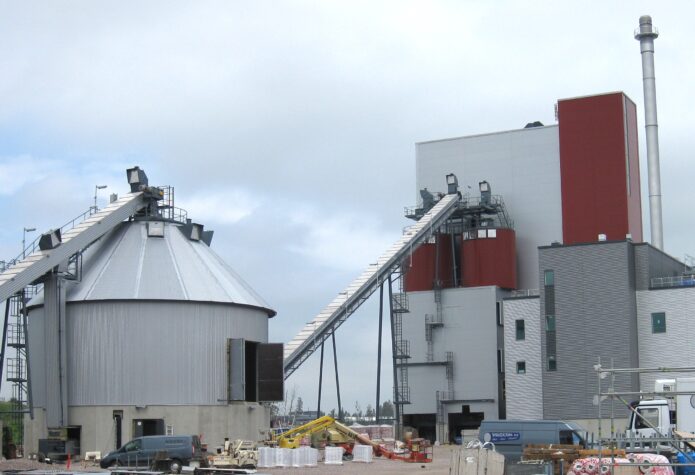Shrinking eco-footprints

In Kerava, a city on the outskirts of the Helsinki metropolitan area, two huge facilities are taking form. One is a recycling centre being expanded and the other a new biopower plant. Both facilities will help reduce carbon dioxide emissions and both have received long-term loans from NIB.
Keravan Lämpövoima is building a new biofuelled combined heat and power plant, due to be ready for commercial use in late 2009. The project is partly financed with a NIB loan of EUR 31.5 million.
With three-fourths of the country covered by forests and woodland, there is seldom a shortfall of wood chips and forest residue in Finland. These biomasses found their way to the energy sector in the 1990s, and now new biopower plants are appearing in various corners of the country. Finland is one of the leading countries in the world in utilising bioenergy. The building of a new biopower plant in the city of Kerava is further strengthening this trend. What makes this project special is that it brings bioenergy to the Finnish capital region for the first time.
The new power plant will generate heat and electricity mainly using wood-based fuels and peat, and is, despite the energy sources’ brown colour, a very green alternative to the current gas-based energy production in Kerava. According to Risto Mäkinen, Managing Director of Keravan Lämpövoima, gas is no longer as feasible a fuel option as in the past, as import prices keep rising and deliveries remain uncertain.Green and secure
“The security of domestically sourced energy was appealing to the project from the start and environmental considerations have played an important part since the beginning of technical planning,” says Mr Mäkinen.
While the energy mix is very flexible, the production will in the beginning be made up of around 40% wood-based fuels and 60% peat. Some peat is always needed for steady wood combustion, but according to Mr Mäkinen, it will be rationed to a minimum: “the key focus lies in utilising biofuels to the greatest extent possible.”
The new power plant is expected to meet 75% of the district heating demand of the city of Kerava and provide 25% of the total electricity acquired by Keravan Energia.
Lassila & Tikanoja (L&T), one of Finland’s biggest companies in waste management, is expanding its existing recycling plant in Kerava. Some 75,000 square metres, the equivalent of ten football fields, have been cleared and enormous facilities are being built. NIB has contributed to the financing of the project with a loan of EUR 15 million.
When the whole plant is ready in 2010, the plant’s capacity will nearly triple, from 170,000 tonnes of waste to some 450,000 tonnes per year. Luckily, it is not the amount of waste produced that will increase that much in the coming years, but a matter of directing more waste to recycling, as well as taking into use new technology.
The plant’s activities are focused on recycling waste materials from commerce and industry, including the building, retail and service sectors. Also paper and cardboard waste from commerce and households are processed.
All wood is being reused
The new line for receiving wood-based waste is already up and running and can process 30 tonnes of waste wood and green waste per hour. Arto Nivalainen, Director of L&T’s Environmental Services, explains the qualities of the new line:
“We receive all kinds of wood from industry, painted or otherwise treated. This reduces the quality of the wood’s reusability. But in the cleaning process pieces of metal and other extra material are separated from the wood. When the wood comes out of the process it is as clean as used wood can be and ready to be burned in biofuelled power plants,” says Mr Nivalainen.
Not all power plants, however, are built in such a way that they can use chips made from used or treated wood, due to the filtering technology in the plant. This is why L&T’s wood processing line is also able to process so-called clean wood such as forest residue.
One of a kind
Another processing line can receive construction and demolition waste as well as commercial and industrial waste from which, for example, stone, metal, glass, and plastic are separated and processed into reusable material. The new line, a so-called combination line, will be able to process almost all kinds of waste and is likely to be the only of its kind in Europe.
“In Central Europe, recycling plants are usually built for one sort of waste only. In Finland, there is not so much waste that it would be efficient to keep a single-waste plant up and running. We need to concentrate our activities on bigger entities, ensure high efficiency and thereby strengthen our competitiveness,” says Mr Nivalainen.
“The amount of waste being reused on this site will increase from the current 75% to 90%. Most of the waste is reused or processed into biofuels and other burnables that can be used by power plants. Only a very small amount is taken to the dump site,” says Jyri Nummela, Production Director of L&T.
Mr Nivalainen’s dream is that 100% of waste would be recycled. “Maybe this could be a reality already in 10 years,” he concludes.
